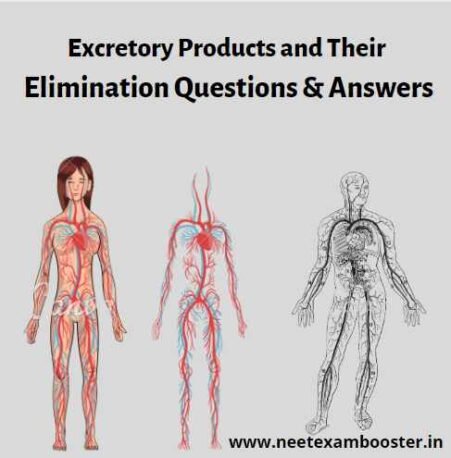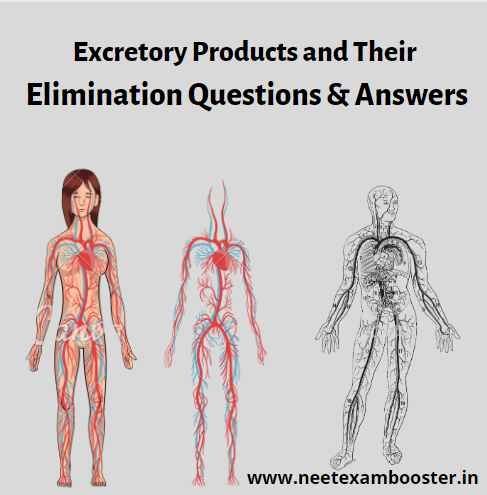Class 11 Biology Chapter 19 Excretory Products and Their Elimination
Metabolic activities or excess ingestion causes animals to accumulate uric acid, urea, water, carbon dioxide and ions such as K+, Na+, sulphate, etc which needs to be eliminated from the body either partially or completely. Ammonotelism, the process of excreting ammonia, which is the most toxic substance and requires large amounts of water to be eliminated. Nitrogenous wastes such as uric acid in form of paste are excreted by reptiles, insects, etc with a few amount of water loss. These animals are known as uricotelic animals. Read on to know more.
Excretory Products and Their Elimination Class 11 – Very Short Answer Type Questions

Q.1.Write the name of the site where selective reabsorption of filtrate from Glomerular occurs.
A.1. PCT – Proximal Convoluted Tubules and DCT – Distal Convoluted Tubules are the site where selective reabsorption of filtrate from glomerular occurs.
Q.2. Write the name of the excretory product of the reptiles from the kidneys.
A.2. Reptiles are the uricotelic animals which excrete nitrogenous wastes in form of uric acid as a paste with the minimum discharge of water.
Q.3. By the sweat gland write the composition of the sweat secreted .
A.3. Sweat is a watery fluid which has NaCl, with the little quantity of urea, lactic acid, etc.
Q.4. Write the name of the gland in prawns performs excretory functions?
A.4. The excretory organs of the prawns are called green glands or antennary glands. Which secrete ammonia & are opaque-white pea-sized structures, they are confined in the coxa of each second antenna.
Q.5. Write the name of the excretory structure in amoeba?
A.5. Contractile vacuole is the excretory structure in amoeba.
Q.6. Give abbreviations of following excretory functions:
a) DCT
b) GFR
c) ADH
d) ANF
A.6.
a).DCT – Distal Convoluted Tubule.
b) GFR – Glomerular Filtration Rate.
c)ADH – Antidiuretic Hormone.
d) ANF – Atrial Natriuretic Factor
Excretory Products and Their Elimination Class 11 Quiz
Q.7. Write the significance of sebaceous glands.
A.7. It is involved in removal of substances, such as wax,cholesterol,squalene, triglycerides, and esters via sebum which provides a greasy covering to the skin.
Q.8.What is the Renin-Angiotensin System?
A.8.Renin-angiotensin system, also known as the renin-angiotensin-aldosterone system. It is a physiological hormone system involved in the regulation of blood plasma, arterial blood pressure and also sodium concentration in our blood cells.
Q.9.What is Micturition?
A.9.The Micturition is a process of urine excretion from the urinary bladder in which the process of micturition consists of two phases — Voiding phase and Storage phase.
Q.10.What is Excretion?
A.10.Excretion is a biological process, which plays a vital role by eliminating toxins and other waste products from the body.
Excretory Products and Their Elimination Class 11 – Short Answer Type Questions
Q.1. Describe the role of Renin-Angiotensin in the management of Kidney function.
A.1. The Juxta-Glomerular Apparatus (JGA) releases renin on activation by fall in the blood flow in the glomerular. In blood, renin transforms angiotensinogen into angiotensin I and hence into angiotensin II which is a vasoconstrictor that raises the blood pressure in the glomerular and hence the Glomerular Filtration Rate(GFR). Also, the angiotensin II stimulates the adrenal cortex to secrete aldosterone, which in turn causes the reabsorption of water and Na+ from the distal parts of the tubule which results in an increase in the GFR and blood pressure, this is termed as RAAS (Renin Angiotensin Aldosterone System).
Q.2 Give any reason why the aquatic animal do mostly ate ammonotelic in nature, whereas terrestrial forms are don’t.
A.2. Ammonia needs a large amount of water for its removal as its the most toxic. To preserve water, terrestrials adapted to the produce less toxic nitrogenous wastes like the uric acid and urea. In almost ureotelic animals, ammonia do released as a result of metabolic activities is preserved into urea in liver and released into the blood that is filtered by the kidneys and excreted also.
Excretory Products and Their Elimination Class 11 study materials
Q.3. Explain why the composition of glomerular filtrate is not similar as urine.
A.3. When the volume of the filtrate is compared with that of the urine that is formed per day, which is 180 liters and 1.5. Liters respectively, Extrapolated that 99% of the filtrate needs to be reabsorbed by the renal tubules, the phenomenon is referred to as absorption again. Substances such as amino acids, Na+, glucose are actively reabsorbed in the filtrate hence are not found in urine.
Q.4. What is the remedial measure advised for the correction of acute renal failure? Explain briefly.
A.4. In ultimate method for the correction of acute renal failure(flop) is Kidney transplantation. The kidney is transplanted from a donor having a functional, suitable kidney, a close relative, preferably, so that the chances of rejection by the host immune system are less(minimized).
Q.5. Why is the hemodialysis unit called as an artificial kidney? Explain briefly.
A.5. It acts as an artificial kidney by eliminating urea from the blood of the patients caused due to failure of the kidney. Blood is drained from the artery and pumped into the dialyzing unit after addition of heparin. The unit has a looped cellophane tube that is girdled by a dialyzing fluid which has a similar composition as plasma minus the nitrogenous waste. The cellophane membrane of the tube is permeable through which molecules pass based upon the concentration gradient. Blood is removed as the nitrogenous wastes are absent in the dialyzing fluid, so they can move freely. The cleaned blood is now pumped back to the body via a vein after supplementing with the anti-heparin.
Excretory Products and Their Elimination Class 11 – Long Answer Type Questions
Q.1. Describe micturition and some disorders of excretory system.
A.1. In the micturition, urine is formed by nephrons which are transferred by the urinary bladder that stores in until a signal is generated by the CNS. This signal is triggered by stretching of urinary bladder because of the filling of urine, that is responded in form of signals to CNS by the stretch receptors present on the bladder walls. To trigger the smooth contractions of bladder muscles, CNS transfers the motor messages and parallelly relaxes urethral sphincter thereby resulting in the release of urine. This phenomenon of releasing the urine is known as micturition Following are the disorders:
The kidney malfunction can cause the urea accumulation in blood, this condition is referred to as uremia that may lead to kidney failure. The Urea in such patients is eliminated through the hemodialysis and kidney transplantation ultimately.
The Renal Calculi is when insoluble or the stones of crystallized salts are formed within kidney.
The Inflammation in glomeruli of the kidney is known as– Glomerulonephritis.
Excretory Products and Their Elimination Class 11 notes
Q.2. Write the role of the tubular secretion to maintain acid-base and ionic balance in the body fluids.
A.2. Tubular cells produce ammonia, H+, and K+ into filtrate during the formation of urine. The tubular secretion assists to maintain the ionic and acid-base balance in the body fluids and it is a necessary step in urine formation. The PCT helps in doing this through the selective secretion of ammonia, hydrogen ions, and the potassium ions into the filtrate. DCT is also able to selectively secrete ions of potassium and hydrogen and ammonia for maintenance of sodium-potassium balance pH in the blood. Another structure which plays a role in maintaining the pH and the ionic balance of blood by selectively secreting H+ and K+ ions is the collecting duct.
Q.3. Why in the loop of Henle,the glomerular filtrate is concentrated in the descending limbs and diluted in the ascending limbs?Give the reason for this.
A.3. The thin wall of Henle’s loop is permeable to the water and not for the solutes. While the isotonic tubular fluid passes down the limb, it slowly loses its water through the exosmosis caused by the increased osmolarity of the medullary interstitium from which limbs stretch. Therefore the filtrate tends to become hypertonic to blood plasma. The ascending limb of loop of Henle is permeable to the ions of K+, Na+, Cl-, partially permeable to the urea, and are impermeable to the water. So, in thick ascending limb of loop of Henle, Ca, Mg, Cl, K, Na is reabsorbed, thereby causing filtrate to become hypotonic to blood plasma and diluted in comparison to descending limb.
Q.4. Define the given one with an suitable examples.
Ammonotelic organisms.
Uricotelic organisms.
Ureotelic organisms.
A.4.
Ammonotelic organisms: They are the organisms that excrete the nitrogenous waste substances in form of ammonia. Examples ofAmmonotelic organisms is Bony fishes, Sepia, Octopus etc.
Uricotelic organisms: They are organisms that excrete the nitrogenous waste substances in form of uric acid. Example of uricotelic organisms are Birds or the lizard, insects, etc.
Ureotelic organisms: They are the organism that excretes the nitrogenous waste substances in form of urea. Examples of Ureotelic organisms are the cartilaginous fish, few bony fishes, adult amphibians and the mammals including humans.
Click here to join our telegram channel for more important questions and answers like this (Excretory Products and Their Elimination Class 11)



















